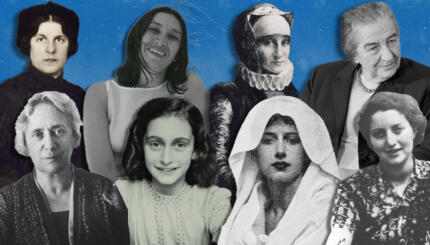I can trace my choice not to go to rabbinical school to a particular moment in time. Rabbi Matthew Cutler was driving me home from a youth group retreat where I had been the song leader. As a senior in college, I was sharing my questions about my next steps– Should I become a Jewish educator or a rabbi? Rabbi Cutler asked, “Do you believe in God?” I feared the question. I felt incompetent to answer it, and I had never done any serious exploration of what I believed. At that moment, I decided to apply for a master’s degree in Jewish Education and pursue my commitment to the Jewish community, but retreat from the idea of becoming a rabbi.
During the first year of my master’s program in Jerusalem, I did a lot of reflecting on why I was so ambivalent about the rabbinate—even as I had a yearning to pray and study Torah, to create and support community, and to serve the Jewish people. I had grown up in an egalitarian, liberal Jewish community and was raised to believe I could be anything I wanted to be. Yet, I saw no one on the
bimah
who looked like me. It wasn’t that I thought I couldn’t be a rabbi. Intellectually, I knew I could, but my own sense of seeing myself on the pulpit was blocked by the lack of women role models before me. Obviously, you know the rest of the story—I became a rabbi—but what bridged the distance?
In that year of living in Israel—studying, reflecting and immersing myself in it all—I became aware that I had a deep sense of calling to be a rabbi. Though I had fears and reservations, I increasingly felt that I should walk right towards them, not run away from them. I came to realize that I could choose to become a rabbi in my own image. I decided I would become the kind of rabbi that felt consonant with who I was and what I believed God was asking me to be in the world.
Fast-forward two years: I was studying modern Jewish thought with Rabbi David Ellenson, and we read
Standing Again at Sinai: Judaism from a Feminist Perspective
by Dr. Judith Plaskow. All of a sudden, I had a much larger understanding of what had informed my ambivalence, even suspicion.
Although I was deeply engaged as a Jew, there was something about the patriarchal structure in the stories I studied that left me subconsciously marginalized. While I was so drawn into the Jewish tradition, its practices, and the Jewish communities I was blessed to be a part of, something was also telling me I didn’t belong. Standing Again at Sinai gave me language to articulate my desire for an embrace of “my Torah” as a woman: a breakdown of the power structure, different language, and metaphors to name God.
Twenty-five years later, an enormous amount has changed in Jewish life and the larger society around us. There is much to celebrate. Not only for the fuller inclusion of women into Jewish life, but also for the pathways towards an expression of Jewish life that, in many ways, were birthed through the Jewish feminist and at-large feminist movements. I am profoundly grateful to Rabbi Matthew Cutler, who asked me the right question at the right time that sent me on a path of discovery. I am also indebted to the Torah of Dr. Plaskow for giving me the language of critique, inspiration to open up new pathways in the search to live out my calling as a rabbi, and for the blessings of creativity and justice that emerged with her book, from which we all reap the benefits.
Rabbi Sol will be speaking at B’nai Jeshurun’s Meet Me at Sinai event this Sunday. It’s a full day of panel discussions, films, dance and more dedicated to the effects of Dr. Judith Plaskow’s Standing Again at Sinai, a book that shook the foundations of Jewish expression with its candid discussion of Jewish feminist theology.
Torah
Pronunced: TORE-uh, Origin: Hebrew, the Five Books of Moses.



